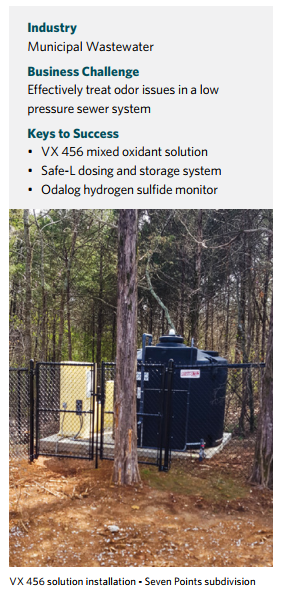Effective Odor Control In a Low Pressure Sewer System
Published on by Water Network Research, Official research team of The Water Network in Technology
When the Metropolitan Government of Nashville and Davidson County received odor complaints from a residential subdivision, Evoqua provided a rapid, cost-effective solution.
 The Metropolitan Government of Nashville and Davidson County received odor complaints from the Seven Points subdivision in Nashville, TN.
The Metropolitan Government of Nashville and Davidson County received odor complaints from the Seven Points subdivision in Nashville, TN.
The community consists of about 150 homes located near the 22 square mile J. Percy Priest Reservoir. The homes in the subdivision each feature grinder pump stations that discharge into a 2.5" to 4" main for transport to a local pump station.
Low pressure sewer systems like this are often used in small communities where wastewater cannot be moved by the force of gravity. In many cases, these systems are found on lake front properties that lie at low elevations relative to pump stations or treatment plants.
Grinder pump systems are prone to hydrogen sulfide production and release due to the small diameter pipes and low linear velocities. In addition, homes owned in lake communities may not be occupied year-round, resulting in longer retention times during periods of low occupancy.
As a result of residential odor complaints, Metro Water Services contacted Evoqua to evaluate the problem and propose a solution.
Evaluating Hydrogen Sulfide Levels
Evoqua measured hydrogen sulfide levels at the intersection of two busy roads where the odor issues had been identified. The hydrogen sulfide graph on page two shows the untreated system experienced peak sulfide concentrations exceeding 950ppmv and an average concentration of 603ppmv.
Treating odors from low pressure sewer systems is complicated by the number of Grinder pumps in the system. An odor control solution application point must be selected that allows the total flow to be treated and provides sufficient reaction time for the solution be effective.
Evoqua proposed dosing VX 456 solution directly into the low pressure force main due to its quick reaction time and specificity towards sulfides in order to establish rapid control over the biofilm in the pipe and to provide a nitrate residual for longer lasting results.
Find full case study in the attachment or download it directly from Evoqua
Media
Taxonomy
- Technology
- Wastewater Collection
- Sewage
- Infrastructure
- Pumps
- Sewer Networks